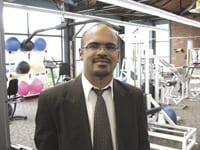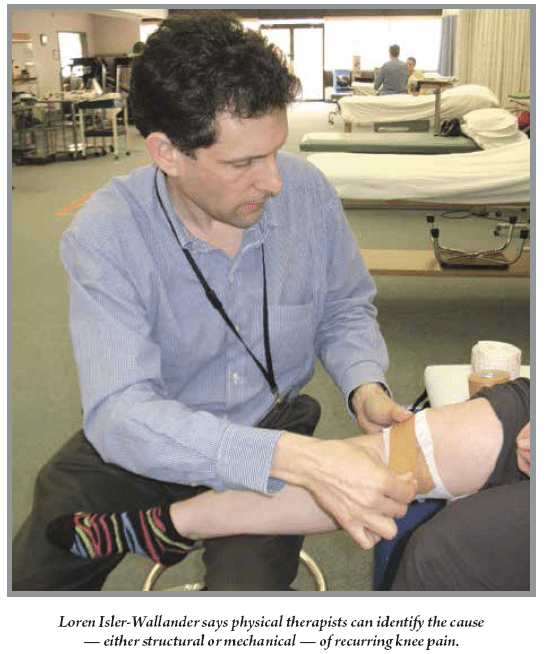Joint Resolutions – When Does Knee Pain Signify a More Serious Issue?
Most people — especially parents — have heard of the ‘terrible twos,’ but how about the ‘terrible toos’? Dr. Julio Martinez-Silvestrini, a sports medicine specialist and medical director of Baystate Rehabilitation Care in Springfield, likes to bring up that trio of traps — too much, too fast, too soon — when talking to patients who are experiencing pain or injury brought on by physical activity.
“You see it with the ‘weekend warriors’— maybe we finally have some nice weather, and they just go out and run two miles after not doing anything the whole winter, and it’s too much.”
Loren Isler-Wallander, a physical therapist at Noble Hospital Sports and Rehabilitation Center in Westfield, knows what that’s like. He said he recently took advantage of an ideal ski-weather day by showing up at the slopes before opening and staying until darkness approached.
“Or someone might want to get that big project done around the house with spring cleaning coming up,” he told HCN. The problem is, these sessions of play or work often cause pain in the knees, one of the most common complaints stemming from physical activity.
“Knees are notorious for having aches and pains,” Isler-Wallander said. “As a matter of fact, if you look at all the joints in the body, the knee is blessed with the thickest cartilage of any joint. This is because it takes so much wear and tear. That’s why we have this extra cushion there.”
But people still tend to overdo activity or go about it in the wrong way, and for those who wake up with pain in their knees the next day, he suggests “the classic RICE recipe” — an acronym that stands for rest, ice, compress, and elevate. In many cases, he said, this recipe will cause the pain to pass within 72 hours, not necessitating a visit to the doctor.
“If it goes away on its own, that’s a shoulder shrug; we wouldn’t be following up with someone on that,” he continued. “But if you experience pain every time you do an activity, you definitely want to follow up with a doctor.”
What to Do?
Martinez-Silvestrini agreed that not all knee pain requires a trip to the doctor, and even an office visit doesn’t necessarily lead to intensive treatment.
“Usually, with the knee, most injuries tend to be non-dangerous, and they will resolve in four to six weeks with what we call conservative care — icing, maybe staying off the knee, maybe taking some over-the counter medications if they’re not contraindicative. But these types of injuries depend a lot on the patient’s age.”
For instance, for teens in the 12-16 age range, many aches aren’t injuries at all, but related to what are often mistakenly called ‘growing pains,’ Martinez- Silvestrini said. “There are a lot of bio-mechanical things happening while we’re growing — the knees are growing longer, and everything else grows right, which could cause some mechanical problems around the knee. That’s a very common source of pain.”
After age 16 and into adulthood, problems with flexibility and changes in the bio-mechanics of the knee often cause problems. Then, in middle age, through the 40’s and 50’s, many knee problems are related to degenerative disease, wear and tear on the joints. “Typically, patients in this group present with conditions resulting from overuse, such as bursitis, tendinitis, and stress fractures,” writes Dr. Jack Andrish, who specializes in sports health at the Cleveland Clinic, in the Journal of Musculoskeletal Medicine.
Those issues grow in prevalence later in life, as some 70{06cf2b9696b159f874511d23dbc893eb1ac83014175ed30550cfff22781411e5} of patients 70 years old and up will have some sort of arthritis in at least one joint. “It’s relatively common as we grow older, obviously,” Martinez Silvestrini said. In addition, he said, no matter what their age, “knee problems may be more common with people who do a lot of weight-bearing activities, or people who have had knee injuries in the past.”
The question, then, for those suddenly suffering knee pain is what to do about it.
“For any type of pain that is limiting your function — not just an ache here and there, but a pain that is really limiting your function — you should seek medical help,” Martinez-Silvestrini said, noting that symptoms such as fever, chills, joint swelling, or redness around the joint are red flags, as well as pain that persists over a period of weeks.
Living with such pain without seeking treatment, he noted, can actually lead to additional complications. “If you have an injury and you’re really hobbling around, you might end up with another problem, like back pain. So if you continue limping, it’s important to seek assistance.”
Isler-Wallander noted some common short-term remedies for knee pain, from Neoprene knee braces to kinesio tape, which is intended to reduce discomfort and inflammation and relax muscles without restricting movement. “That’s very popular right now.”
Primary-care physicians can’t always diagnose pain properly, he told HCN, and will typically refer patients to a physical therapist or other specialist. And the first thing a therapist needs to decide, he said, is whether a problem is structural or mechanical, which he compared to a door that doesn’t shut properly. “If the door frame is crooked, you have to fix the structure; the way the pieces fit together isn’t quite right. But if everything seems to be in place but the door just won’t swing shut, maybe a joint is rusted; there’s a mechanical problem preventing it from working.”
As an example of mechanical issues, he cited a casual basketball player who lands awkwardly each time he lands on the ground after going up for a rebound. “If I did that game after game, practice after practice, of course it would hurt,” he said. Once the mechanical flaw is diagnosed, the athlete can build strength and proper control through repetition.
The Sporting Life
Martinez-Silvestrini said that many injuries and pain are caused simply by not being ready to engage in a certain recreational activity.
“One thing I learned during my sports and medical training is that you should be fit to play your sport, not play sports to be fit. Exercise to be fit, then play sports,” he said. “A lot of people play basketball or other sports with their friends, and the reality is that they’re just not ready, and they overuse joints.”
That applies to exercise, too, and not just sports, Andrish notes. He recommends that individuals who are just beginning a workout regimen follow the 10{06cf2b9696b159f874511d23dbc893eb1ac83014175ed30550cfff22781411e5} rule, which means limiting themselves to increases in intensity, pace, or weight of no more than 10{06cf2b9696b159f874511d23dbc893eb1ac83014175ed30550cfff22781411e5} per week. Isler-Wallander agrees that many new exercise fans have more enthusiasm than knowledge.
“What most people don’t realize when they do their workout that it’s not just strength they should focus on, but flexibility,” he told HCN. “That’s so critical; you should be spending as much time working on flexibility as strength, especially as you age.”
Another common issue is equipment that doesn’t fit well — ice skates that are a size too big, laces in bad shape, or padding that’s worn out, for example. “I think any type of equipment should be inspected regularly and replaced accordingly,” Martinez-Silvestrini said. “Padding needs to be readjusted, blades sharpened, and you need to keep good maintenance of everything. It’s very important that equipment fits well and isn’t worn out.”
Perhaps most importantly, he added, “you need to listen to your body. In the past, we used to say, ‘no pain, no gain,’ but I think we should say ‘no pain, play safe.’
“Pain is the most important marker of injury, your body’s way of telling you to back off,” he continued. “People sometimes confuse that with the burn someone feels from working out. That’s completely different from pain that limits your activity. You need to listen to your body; if you think you’re doing too much, you probably are, and you should back off.”
That sort of caution, after all, will lead to plenty more active weekends — and much less pain for the warriors.






Comments are closed.